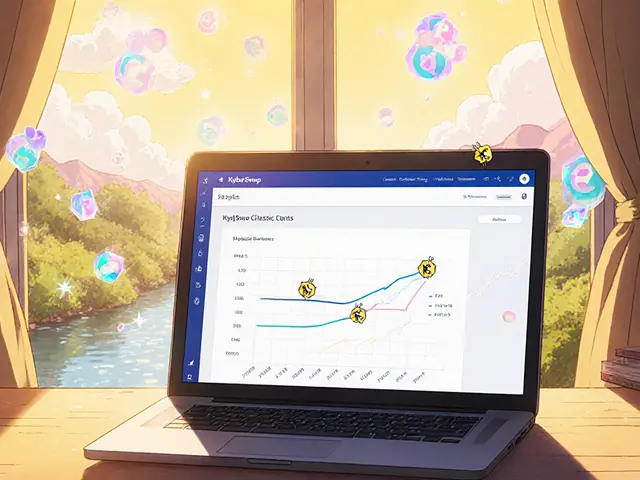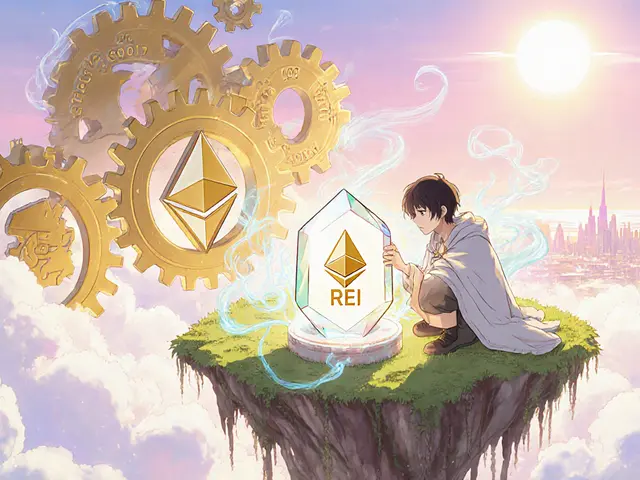22
Velodrome Finance (VELO) Explained: How the Optimism DEX Works

VELO Earnings Calculator
Liquidity Parameters
How It Works
VELO
Native token
veVELO
Voting-escrowed token
Your earnings come from two sources:
- Swap fees: 0.04-0.30% (dynamic based on pool volatility)
- VELO emissions: Up to 70% of weekly emissions allocated via bribe mechanism
Note: These are estimates based on current parameters. Actual earnings may vary due to market conditions and governance decisions.
When you first see the name Velodrome Finance is a decentralized exchange (DEX) and liquidity protocol built on Optimism’s Layer 2 scaling solution for Ethereum, it can feel like another buzzword in the crowded crypto space. In reality, Velodrome tackles a very specific problem: how new tokens get enough liquidity on Optimism without depending on the massive, often inefficient pools that dominate Ethereum’s mainnet. Below we break down what makes Velodrome unique, how the VELO token powers the system, and what you should watch before jumping in.
What is Velodrome Finance?
Launched in February 2022, Velodrome Finance operates as both a swap platform for traders and a liquidity marketplace for emerging protocols. Its core mission is to solve the “chicken‑and‑egg” dilemma where projects need liquidity to attract traders, but traders need liquidity to trade. By aligning incentives directly between token projects and liquidity providers (LPs), Velodrome creates a self‑sustaining ecosystem.
The protocol runs on Optimism is a Layer 2 scaling solution for Ethereum that offers low fees and high throughput, which means swaps cost around $0.001 compared to roughly $1.50 on Ethereum mainnet. As of Q3 2024, more than $100 million is locked in Velodrome’s pools, and daily trading volume hovers around $50 million.
How the VELO token works
The native token, VELO is a governance and fee‑distribution token that powers Velodrome’s incentive model, serves two main purposes. First, it grants holders the ability to lock their tokens and receive veVELO is a voting‑escrowed form of VELO that provides voting power and a share of protocol fees. Second, the token is used to emit rewards to LPs and to pay for the “bribe” mechanism that lets external projects steer liquidity toward their pools.
Lock periods range from one week up to 14 days, with voting power decaying linearly over the lock term. This design, known as ve(3,3) tokenomics is a framework that combines vote‑escrowed tokens, emission control, and a fee‑share model to align incentives, mirrors the model pioneered by OlympusDAO but tailors it for a DEX environment.
Key features: ve(3,3) and the bribe mechanism
Velodrome’s biggest differentiator is its built‑in bribe system. Project teams can allocate a portion of their own token emissions to a “bribe pool,” effectively paying veVELO holders to direct a slice of Velodrome’s weekly VELO emissions toward that project’s liquidity pool. This creates a marketplace where liquidity incentives are decided by the community rather than a centralized rewards contract.
Because veVELO holders control up to 70 % of weekly emissions, they can collectively decide which pools get the most boost. In practice, this means an emerging token can jump from a thin, 10‑k liquidity pool to a healthy 500‑k pool within weeks if enough veVELO voters agree to allocate emissions.
Analysts at Nansen measured a 37 % higher liquidity depth for projects using Velodrome’s bribe model versus traditional mining programs, highlighting the efficiency of this market‑driven approach.
Liquidity pools and AMM design
Velodrome employs an Automated Market Maker is a smart‑contract based protocol that automatically sets prices based on pool reserves (AMM) similar to Uniswap, but with two key upgrades:
- Customizable pool types: Stable pools for assets with near‑identical prices (e.g., USDC/USDT) and volatile pools for regular token pairs.
- Concentrated liquidity: LPs can allocate capital within specific price ranges, improving capital efficiency by up to 22 % after the V2 upgrade in August 2024.
The protocol also supports dynamic fee tiers, meaning pools with higher volatility can charge larger fees to compensate LPs for risk, while stable pools enjoy lower fees to attract volume.

Governance and emissions
All major decisions-emission allocations, fee structures, treasury spending-are voted on by veVELO holders. Proposals are submitted through Velodrome’s governance portal and require a quorum of 1 % of total veVELO voting power to be considered. Once passed, changes are executed automatically by the smart contracts.
The weekly emissions schedule releases roughly 2.5 % of total VELO supply, with a four‑year ramp‑down plan. Critics from Delphi Digital warn that the decreasing emissions could shrink fee revenue by up to 65 % after 2026 if alternative incentive sources aren’t introduced.
Performance metrics and growth
According to DefiLlama, Velodrome held the #1 spot among Optimism‑native DEXs with $142 million TVL in October 2024, outpacing Synthetix DEX ($87 million) and Kwenta ($42 million). Daily active users reached 14,200 in October 2024, a three‑fold increase from Q1 2023.
Security audits by CertiK in September 2024 rated the contracts as “medium risk,” noting three medium‑severity re‑entrancy bugs that were promptly patched. The community’s average rating on Holder.io stands at 4.2 / 5, reflecting strong APY performance but also pointing to a learning curve for newcomers.
Risks and considerations
While Velodrome’s design solves many liquidity challenges, it carries a few caveats:
- Layer‑2 confinement: It operates exclusively on Optimism, limiting cross‑chain liquidity exposure.
- Complex tokenomics: New users often stumble on ve(3,3) mechanics; community surveys show an average 45‑minute onboarding time.
- Emission reliance: The protocol’s health is tied to ongoing VELO emissions, which will taper after the four‑year schedule.
Potential investors should weigh these factors against the high APY yields reported by early LPs-some users claim $350 weekly returns on a $10k VELO/USDC position after accounting for fees and impermanent loss.

Getting started: step‑by‑step guide
- Install an EVM‑compatible wallet (MetaMask, Trust Wallet, etc.) and add the Optimism network (Chain ID 10).
- Bridge assets from Ethereum to Optimism using the official Optimism Bridge or a third‑party bridge like Hop.
- Navigate to velodrome.finance and connect your wallet.
- Choose a pool-stable or volatile-based on the assets you want to swap or provide liquidity for.
- If you intend to earn emissions, lock VELO for veVELO (minimum 1 week). Set your lock period, confirm the transaction, and watch your voting power appear.
- Participate in governance votes by accessing the “Vote” tab; allocate a portion of weekly emissions to your preferred pools.
- Monitor performance via the built‑in analytics dashboard or third‑party tools like DefiLlama.
Typical onboarding time is eight minutes for the first swap and an additional twelve minutes if you also provide liquidity.
Comparing Velodrome with other DEXs
| Feature | Velodrome Finance | Uniswap v3 | Curve |
|---|---|---|---|
| Base Layer | Optimism (L2) | Ethereum Mainnet | Ethereum Mainnet |
| Concentrated Liquidity | Yes, with dynamic fee tiers | Yes | No (stable‑coin focused) |
| Built‑in Incentive Mechanism | Bribe system + ve(3,3) | External liquidity mining only | Limited liquidity mining |
| Typical Swap Fee | 0.04‑0.30 % (dynamic) | 0.05 % | 0.04‑0.04 % (stable pools) |
| TVL (Oct 2024) | $142 M (Optimism) | $5.2 B (Ethereum) | $8.7 B (Ethereum) |
Velodrome’s combination of low fees, customizable pools, and a community‑driven bribe model makes it a compelling choice for projects launching on Optimism.
Future outlook
Roadmap milestones include expanding to all OP‑Stack chains by Q2 2025, integrating Ethereum’s upcoming “Prague” hard fork for smoother L1‑L2 messaging, and launching a protocol‑owned liquidity module in Q4 2025. Analysts at Galaxy Digital project that Velodrome could capture 15‑20 % of Optimism’s DEX market share by 2026, assuming the cross‑chain rollout proceeds smoothly.
However, centralization risk remains a concern; as of October 2024, the top 100 wallets control about 63 % of veVELO voting power. Diversifying governance participation will be crucial for long‑term resilience.
What chain does Velodrome run on?
Velodrome is deployed on the Optimism Layer 2 network (chain ID 10), which offers fast transactions and very low fees compared to Ethereum’s mainnet.
How do I earn rewards with VELO?
Lock VELO to receive veVELO, then provide liquidity to a pool. You’ll earn a share of swap fees plus any emissions allocated by the community or bribes from projects.
Is Velodrome safe to use?
The contracts have passed multiple audits, including a recent CertiK review that flagged three medium‑severity issues which were patched. As with any DeFi platform, use a reputable wallet and only allocate capital you can afford to lose.
Can I trade assets that aren’t on Optimism?
Only assets that exist on Optimism can be swapped directly. You’d need to bridge tokens from Ethereum or another L2 to Optimism first.
What’s the difference between VELO and veVELO?
VELO is the tradable token. When you lock VELO, you receive veVELO, which grants voting rights and a slice of protocol fees. The longer you lock, the more veVELO you get.








